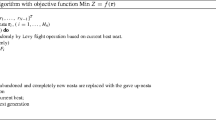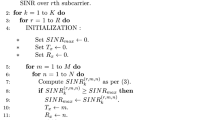Abstract
Orthogonal frequency division multiplexing (OFDM) is a spectral efficient multi-carrier modulation technique which offers many advantages in wireless as well as wired communication systems. Major issues of OFDM implementation are its high peak to average power ratio (PAPR) and extreme sensitivity to carrier frequency offset (CFO). In this paper, we propose a new scheme named optimum null swapping for combined PAPR reduction and CFO estimation in OFDM systems by using one training symbol (pilot) with some null subcarriers embedded in it. We exploit certain number of nulls in the pilot symbol for swapping with some data subcarriers of the data block in such a way as to reduce PAPR. By the proper allocation of null subcarriers based on some specific sequences at the transmitter, CFO is estimated at the receiver using the same pilot OFDM symbol. The computational complexity of the new objective function for the proposed joint optimum null swapping scheme is made significantly low by using the Tabu search algorithm. Moreover, the proposed method demands less side information to be send to the receiver for the reverse swapping of nulls in order to retrieve original data symbols. Simulation results show that the proposed joint scheme offers substantial reduction in PAPR apart from CFO estimation without any additional bandwidth overhead.





Similar content being viewed by others
References
Hwang, T., Yang, C., Wu, G., Li, S., & Li, G. Y. (2009). Ofdm and its wireless applications: A survey. IEEE Transactions on Vehicular Technology, 58(4), 1673–1694.
Wang, Y., & Luo, Z. (2011). Optimized iterative clipping and filtering for PAPR reduction of OFDM signals. IEEE Transactions on Communications, 59(1), 33–37.
Cha, S., Park, M., Lee, S., Bang, K.-J., & Hong, D. (2008). A new PAPR reduction technique for OFDM systems using advanced peak windowing method. IEEE Transactions on Consumer Electronics, 54(2), 405–410.
Wang, Y., Wang, L.-H., Ge, J.-H., & Ai, B. (2012). An efficient nonlinear companding transform for reducing PAPR of OFDM signals. IEEE Transactions on Broadcasting, 58(4), 677–684.
Taspinar, N., Kalinli, A., & Yildirim, M. (2011). Partial transmit sequences for PAPR reduction using parallel tabu search algorithm in ofdm systems. IEEE Communications Letters, 15(9), 974–976.
Bäuml, R. W., Fischer, R. F., & Huber, J. B. (1996). Reducing the peak-to-average power ratio of multicarrier modulation by selected mapping. IET Electronics Letters, 32(22), 2056–2057.
Wong, K., Wang, B., & Chen, J.-C. (2011). OFDM PAPR reduction by switching null subcarriers and data-subcarriers. IET Electronics Letters, 47(1), 62–63.
Wang, B., Ho, P.-H., & Lin, C.-H. (2012). OFDM PAPR reduction by shifting null subcarriers among data subcarriers. IEEE Communications Letters, 16(9), 1377–1379.
Duanmu, C., & Chen, H. (2014). Reduction of the PAPR in OFDM systems by intelligently applying both PTS and SLM algorithms. Wireless Personal Communications, 74(2), 849–863.
Meymanatabadi, S., Niya, J. M., & Mozaffari, B. (2013). Selected mapping technique for PAPR reduction without side information based on m-sequence. Wireless Personal Communications, 71(4), 2523–2534.
Goel, A., Gupta, P., & Agrawal, M. (2014). Generalized M–2M mapping scheme for SLM and PTS based OFDM systems without side-information. Wireless Personal Communications, 74(2), 285–305.
Schmidl, T. M., & Cox, D. C. (1997). Robust frequency and timing synchronization for OFDM. IEEE Transactions on Communications, 45(12), 1613–1621.
Seo, B.-S., Kim, S.-C., & Park, J. (2002). Fast coarse frequency offset estimation for OFDM systems by using differentially modulated subcarriers. IEEE Transactions on Consumer Electronics, 48(4), 1075–1081.
Morelli, M., & Mengali, U. (1999). An improved frequency offset estimator for OFDM applications. IEEE Communications Letters, 3(3), 75–77.
Kim, Y.-H., & Lee, J.-H. (2011). Joint maximum likelihood estimation of carrier and sampling frequency offsets for OFDM systems. IEEE Transactions on Broadcasting, 57(2), 277–283.
Liang, Y.-J., Stuber, G. L., Chang, J.-F., & Yang, D.-N. (2012). A joint channel and frequency offset estimator for the downlink of coordinated MIMO–OFDM systems. IEEE Transactions on Wireless Communications, 11(6), 2254–2265.
Huang, D., & Letaief, K. B. (2006). Carrier frequency offset estimation for ofdm systems using subcarriers. IEEE Transactions on Communications, 54(5), 813–823.
Simon, E. P., Ros, L., Hijazi, H., & Ghogho, M. (2012). Joint carrier frequency offset and channel estimation for OFDM systems via the EM algorithm in the presence of very high mobility. IEEE Transactions on Signal Processing, 60(2), 754–765.
Lin, D. D., Pacheco, R. A., Lim, T. J., & Hatzinakos, D. (2006). Joint estimation of channel response, frequency offset, and phase noise in OFDM. IEEE Transactions on Signal Processing, 54(9), 3542–3554.
Ge, L., Zhao, Y., Wu, H., Xu, N., Jin, Y., & Li, W. (2010). Joint frequency offset tracking and PAPR reduction algorithm in OFDM systems. IEEE Journal of Systems Engineering and Electronics, 21(4), 557–561.
Priya, C., & Suganthi, M. (2010, July). Combined PAPR reduction and frequency offset estimation using precoded Zadoff-Chu OFDM in WLAN system. In Proceedings of 3rd IEEE International Conference on Computer Science and Information Technology (ICCSIT) ( Vol. 3, pp. 461–465).
Prasad, R. (2004). OFDM for wireless communications systems. London: Artech House Publishers.
Glover, F. (1989). Tabu search part I. ORSA Journal of Computing, 1(3), 190–206.
Wang, L., & Liu, J. (2011). PAPR reduction of OFDM signals by PTS with grouping and recursive phase weighting methods. IEEE Transactions on Broadcasting, 57(2), 299–306.
Wang, C.-L., & Ouyang, Y. (2005). Low-complexity selected mapping schemes for peak-to-average power ratio reduction in OFDM systems. IEEE Transactions on Signal Processing, 53(12), 4652–4660.
Author information
Authors and Affiliations
Corresponding author
Rights and permissions
About this article
Cite this article
Namitha, A.S., Sameer, S.M. A Novel Joint Method for Frequency Offset Estimation and Peak-to-Average Power Ratio Reduction in OFDM Systems Using Null Subcarriers. Wireless Pers Commun 83, 343–359 (2015). https://doi.org/10.1007/s11277-015-2396-0
Published:
Issue Date:
DOI: https://doi.org/10.1007/s11277-015-2396-0




